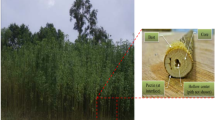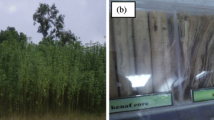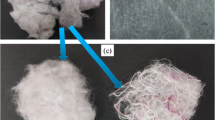Abstract
In this study, Kenaf fibre–reinforced polymer (KFRP) composites containing 10%, 30% and 40% of fibre volume fractions were produced to examine the effects of ageing on the polymer composites. The samples were exposed to a laboratory environment (the control sample), outdoor environment, along with immersion in water and acid (5 wt.%, H2SO4) for 12- and 24-month exposure periods. The control samples were stored under normal and darkroom conditions followed by the comprehensive characterisation of the physical properties and mechanical performance attributes of the composites. The results revealed significant surface degradation, while fungal growth, surface roughness and discolouration were observed on sample surfaces exposed to outdoor conditions after 12 and 24 months. The unexposed samples displayed higher tensile and compressive properties compared to the exposed samples. The higher fibre volume fractions resulted in higher mechanical properties and weathering degradation. The tensile strength of the Kenaf/epoxy composite with a fibre volume content of 40% was 31%, which is 133% higher than the 10% and 30% fractions. Kenaf/vinyl ester composites displayed the highest mechanical properties followed by the Kenaf/polyester and Kenaf/epoxy composites after 12- and 24-month ageing. Therefore, the KFRP composites are suited for lumber-based floor finishing, wall panels, ceiling finishing, doors and windows panels.













Similar content being viewed by others
References
Basri MHA, Abdu A, Junejo N, Hamid HA, Ahmed K (2014) Journey of kenaf in Malaysia: a review. Scientific Research and Essays 9(11):458–470
van Dam JE Natural fibres and the environment: environmental benefits of natural fibre production and use. In: Proceedings of the Symposium on Natural Fibres: Common fund for commodities, 20 October 2008, Rome, Italy, 2008. pp 3–17
Gurunathan T, Mohanty S, Nayak SK (2015) A review of the recent developments in biocomposites based on natural fibres and their application perspectives. Compos A Appl Sci Manuf 77:1–25
Rangappa SM, Siengchin S, Dhakal HN (2020) Green-composites: eco-friendly and sustainability. Applied Science and Engineering Progress 13(3):183–184
Razavi M, Babatunde OE, Yatim JM, Razavi M, Azzmi NM (2018) Compressive properties of Kenaf/Vinylester composite with different fibre volume. Adv Sci Lett 24(6):3894–3897
Chang BP, Mohanty AK, Misra M (2020) Studies on the durability of sustainable biobased composites: a review. RSC Adv 10(31):17955–17999
Aluko OG, Yatim JM, Kadir MAA, Yahya K (2020) A review of properties of bio-fibrous concrete exposed to elevated temperatures. Construction and Building Materials 260:119671
Ajouguim S, Stefanidou M, Abdelouahdi K, Waqif M, Saâdi L (2020) Influence of treated bio-fibres on the mechanical and physical properties of cement mortars. European Journal of Environmental and Civil Engineering:1–15
Ouarhim W, Zari N, Bouhfid R, Qaiss Aek (2019) Mechanical performance of natural fibres–based thermosetting composites. In: Jawaid M, Thariq M, Saba N (eds) Mechanical and physical testing of biocomposites, fibre-reinforced composites and hybrid composites. Woodhead Publishing, pp 43–60.
David G, Vannini M, Sisti L, Marchese P, Celli A, Gontard N, Angellier-Coussy H (2020) Eco-conversion of two winery lignocellulosic wastes into fillers for biocomposites: vine shoots and wine pomaces. Polymers 12(7):1530
Nyakuma BB, Ivase TJ-P (2021) Emerging trends in sustainable treatment and valorisation technologies for plastic wastes in Nigeria: a concise review. Environmental Progress & Sustainable Energy:e13660
Ogunbode EB, Egba EI, Olaiju OA, Elnafaty AS, Kawuwa SA (2017) Microstructure and mechanical properties of green concrete composites containing coir fibre. Chem Eng Trans 61:1879–1884
Moudood A, Hall W, Öchsner A, Li H, Rahman A, Francucci G (2019) Effect of moisture in flax fibres on the quality of their composites. Journal of Natural Fibers 16(2):209–224
Sahu P, Gupta M (2020) A review on the properties of natural fibres and its bio-composites: Effect of alkali treatment. Proceedings of the Institution of Mechanical Engineers, Part L: Journal of Materials: Design and Applications 234(1):198–217
Nyakuma BB, Wong SL, Oladokun O, Bello AA, Hambali HU, Abdullah TAT, Wong KY (2020) Review of the fuel properties, characterisation techniques, and pre-treatment technologies for oil palm empty fruit bunches. Biomass Conversion and Biorefinery. https://doi.org/10.1007/s13399-13020-01133-x
Babatunde OE, Yatim JM, Ishak MY, Masoud R, Meisam R (2015) Potentials of kenaf fibre in bio-composite production: A review. Jurnal Teknologi 77 (12)
Ali JB, Musa AB, Danladi A, Bukhari MM, Nyakuma BB (2020) Physico-mechanical properties of unsaturated polyester resin reinforced maize cob and jute fibre composites. Journal of Natural Fibers:1–21
Shaker K, Nawab Y, Jabbar M (2020) Bio-composites: eco-friendly substitute of glass fiber composites. In: Kharissova OV, Martínez LMT, Kharisov BI (eds) Handbook of nanomaterials and nanocomposites for energy and environmental applications. Springer International Publishing, Cham, pp 1–25
Thyavihalli Girijappa YG, Mavinkere Rangappa S, Parameswaranpillai J, Siengchin S (2019) Natural fibers as sustainable and renewable resource for development of eco-friendly composites: a comprehensive review. Frontiers in Materials 6 (226).
Wambua P, Ivens J, Verpoest I (2003) Natural fibres: can they replace glass in fibre reinforced plastics? Compos Sci Technol 63(9):1259–1264
Pickering KL, Efendy MA, Le TM (2016) A review of recent developments in natural fibre composites and their mechanical performance. Compos A Appl Sci Manuf 83:98–112
Avanaki MJ, Abedi M, Hoseini A, Maerefat MS (2018) Effects of fibre volume fraction and aspect ratio on mechanical properties of hybrid steel fibre reinforced concrete. Journal of New Approaches in Civil Engineering 2(2):49–64
Manaia JP, Manaia AT, Rodriges L (2019) Industrial hemp fibers: an overview. Fibers 7(12):106
Ho M-p, Wang H, Lee J-H, Ho C-k, Lau K-t, Leng J, Hui D (2012) Critical factors on manufacturing processes of natural fibre composites. Compos B Eng 43(8):3549–3562
Shesan OJ, Stephen AC, Chioma AG, Neerish R, Rotimi SE (2019) Fiber-matrix relationship for composites preparation. In: Renewable and Sustainable Composites. IntechOpen
Ali JB, Musa A, Danladi A, Bukhari M, Nyakuma BB (2020) Physico-mechanical properties of unsaturated polyester resin reinforced maize cob and jute fibre composites. Journal of Natural Fibers:https://doi.org/10.1080/15440478.15442020.11841062.
Abdulkareem S, Adeniyi A, Amosa M, Raji S (2020) Development of plastic composite using waste sawdust, rice husk and bamboo in the polystyrene-based resin (PBR) matrix at ambient conditions. In: Valorization of biomass to value-added commodities. Springer, pp 423–438
Arbaoui S, Evlard A, Mhamdi MEW, Campanella B, Paul R, Bettaieb T (2013) Potential of kenaf (Hibiscus cannabinus L.) and corn (Zea mays L.) for phytoremediation of dredging sludge contaminated by trace metals. Biodegradation 24(4):563–567
Mariod AA, Saeed Mirghani ME, Hussein I (2017) Hibiscus cannabinus L. Kenaf. In: Mariod AA, Saeed Mirghani ME, Hussein I (eds) Unconventional oilseeds and oil sources. Academic Press, United States, pp 45–51
Sapiai N, Jumahat A, Jawaid M, Midani M, Khan A (2020) Tensile and flexural properties of silica nanoparticles modified unidirectional kenaf and hybrid glass/kenaf epoxy composites. Polymers 12(11):2733
Mohapatra S, Ray RC, Ramachandran S (2019) Bioethanol from biorenewable feedstocks: technology, economics, and challenges. In: Ray RC, Ramachandran S (eds) Bioethanol production from food crops. Academic Press, United States of America, pp 3-27
Sapiai N, Jumahat A, Shaari N, Tahir A (2020) Mechanical properties of nanoclay-filled kenaf and hybrid glass/kenaf fiber composites. Materials Today: Proceedings
Sharba MJ, Salman SD, Leman Z, Sultan MT, Ishak MR, Hanim MAA (2016) Effects of processing method, moisture content, and resin system on physical and mechanical properties of woven kenaf plant fibre composites. BioResources 11(1):1466–1476
Hasan N, Sobuz HR, Auwalu AS, Tamanna N (2015) Investigation into the suitability of kenaf fibre to produce structural concrete. Adv Mater Lett 6(8):731–737
Edeerozey AM, Akil HM, Azhar A, Ariffin MZ (2007) Chemical modification of kenaf fibres. Mater Lett 61(10):2023–2025
Patel M, Weidemann F, Schleich J, Husing B, Angerer G (2005) Tehno-economic feasibility of large-scale production of bio-based polymers in Europe. European Commission. Joint Research Centre (DG JRC). Institute for Prospective Technological Studies:37–49
Crank M, Patel M, Marscheider-Weidemann F, Schleich J, Hüsing B, Angerer G (2004) Techno-economic feasibility of large-scale production of bio-based polymers in Europe (PRO-BIP). Final report. Department of Science
Bourguignon M (2016) Growth, productivity, and utilization of kenaf (Hibiscus cannabinus L.): a promising fibre and fuel crop for Iowa. Doctoral Thesis, Iowa State University, Ames, Iowa
Wang Q, Jones J, Lu N, Johnson R, Ning H, Pillay S (2018) Development and characterization of high-performance kenaf fibre–HDPE composites. J Reinf Plast Compos 37(3):191–200
Saba N, Paridah M, Jawaid M (2015) Mechanical properties of kenaf fibre reinforced polymer composite: a review. Constr Build Mater 76:87–96
Saba N, Jawaid M, Hakeem K, Paridah M, Khalina A, Alothman O (2015) Potential of bioenergy production from industrial kenaf (Hibiscus cannabinus L.) based on Malaysian perspective. Renew Sustain Energy Rev 42:446–459
Nayak SY, Sultan MTH, Shenoy SB, Kini CR, Samant R, Shah AUM, Amuthakkannan P (2020) Potential of natural fibers in composites for ballistic applications–a review. Journal of Natural Fibers:1–11.
Ogunbode EB, Nyakuma BB, Jimoh RA, Lawal TA, Nmadu HG (2021) Mechanical and microstructure properties of cassava peel ash-based kenaf bio-fibrous concrete composites. Biomass Conversion and Biorefinery:https://doi.org/10.1007/s13399-13021-01588-13396.
Teng S, Afroughsabet V, Ostertag CP (2018) Flexural behaviour and durability properties of high-performance hybrid-fibre-reinforced concrete. Constr Build Mater 182:504–515
Zhang P, Li Q-f (2013) Effect of polypropylene fibre on the durability of the concrete composite containing fly ash and silica fume. Compos B Eng 45(1):1587–1594
Mahjoub R, Yatim JM, Sam ARM, Hashemi SH (2014) Tensile properties of kenaf fibre due to various conditions of chemical fibre surface modifications. Constr Build Mater 55:103–113
Andrew RM (2018) Global CO2 emissions from cement production. Earth System Science Data 10(1):195–217
Wong SL, Nyakuma BB, Nordin AH, Lee CT, Ngadi N, Wong KY, Oladokun O (2020) Uncovering the dynamics in global carbon dioxide utilization research: a bibliometric analysis (1995–2019). Environmental Science and Pollution Research
Ku H, Wang H, Pattarachaiyakoop N, Trada M (2011) A review on the tensile properties of natural fibre-reinforced polymer composites. Compos B Eng 42(4):856–873
George J, Sreekala M, Thomas S (2001) A review on interface modification and characterization of natural fibre-reinforced plastic composites. Polym Eng Sci 41(9):1471–1485
ASTM D3039/D3039M - 14 (2008) Tensile properties of polymer matrix composite materials. Mechanical Properties. ASTM International, West Conshohocken, PA, USA
Mohammed M, Chai YY, Doh SI, Lim KS Degradation of glass fiber reinforced polymer (GFRP) material exposed to tropical atmospheric condition. In: Key engineering materials, 2021. Trans Tech Publ, pp 265-274
Liew Y, Tan K (2003) Durability of GFRP composites under tropical climate. In: Fibre-reinforced polymer reinforcement for concrete structures: (In 2 Volumes). World Scientific, pp 769–778
Yew G, Chow W, Mohd Ishak Z, Mohd Yusof A (2009) Natural weathering of poly (lactic acid): effects of rice starch and epoxidized natural rubber. J Elastomers Plast 41(4):369–382
Potočić Matković V, Skenderi Z (2017) Influence of modification on the structural and tensile properties of polyurethane coated knitted fabrics after natural weathering. Fibres & Textiles in Eastern Europe
Azwa Z, Yousif B (2013) Characteristics of kenaf fibre/epoxy composites subjected to thermal degradation. Polym Degrad Stab 98(12):2752–2759
Ismail N, Ishak Z Effect of fibre loading on mechanical and water absorption capacity of polylactic acid/polyhydroxybutyrate-co-hydroxyhexanoate/kenaf composite. In: IOP Conference Series: materials science and engineering, 2018. vol 1. IOP Publishing, p 012014
Bera T, Mohanta N, Prakash V, Pradhan S, Acharya SK (2019) Moisture absorption and thickness swelling behaviour of Luffa fibre/epoxy composite. J Reinf Plast Compos 38(19–20):923–937
Mazuki AAM, Akil HM, Safiee S, Ishak ZAM, Bakar AA (2011) Degradation of dynamic mechanical properties of pultruded kenaf fiber reinforced composites after immersion in various solutions. Compos B Eng 42(1):71–76
Author information
Authors and Affiliations
Corresponding authors
Additional information
Publisher's note
Springer Nature remains neutral with regard to jurisdictional claims in published maps and institutional affiliations.
Rights and permissions
About this article
Cite this article
Razavi, M., Ogunbode, E.B., Nyakuma, B.B. et al. Fabrication, characterisation and durability performance of kenaf fibre reinforced epoxy, vinyl and polyester-based polymer composites. Biomass Conv. Bioref. 13, 9165–9180 (2023). https://doi.org/10.1007/s13399-021-01832-z
Received:
Revised:
Accepted:
Published:
Issue Date:
DOI: https://doi.org/10.1007/s13399-021-01832-z




